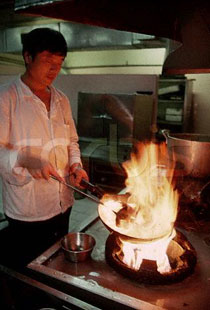Serving

Lorem ipsum dolor sit amor
Food must be handled safely not only before it is served but also while it is being served. Therefore, equipment used to keep foods hot or cold before and during serving must be properly maintained. Foodservice workers and servers must also be trained about safe food handling practices.
Hot–Holding Food
- Hold potentially hazardous food at 135°F (57°C) or hotter.
- Only use hot–holding equipment that keeps food at 135°F (57°C) or hotter.
- Never use hot–holding equipment to reheat food.
- Check food temperatures with a thermometer at least every four hours.
- Protect food from contaminants with covers or sneeze guards.
- Prepare food in small batches so food is not held for long periods of time.
Cold–holding Food
- Hold cold food that is potentially hazardous food at 41°F (5°C) or colder.
- Only use cold–holding equipment that can keep food at 41°F (5°C) or colder.
- Do not store food directly on ice.
- Check food temperatures with a thermometer at least every four hours.
- Protect food from contaminants with covers or sneeze guards.
- Prepare food in small batches so food is not held for long periods of time.
Holding Potentially Hazardous Food without Temperature Control
Under certain circumstances ready–to–eat, potentially hazardous food can be displayed or held for consumption without temperature control. Before removing the food from temperature control, the food must be at 41°F (5°C) or colder or at 135°F (57°C) or hotter. Potentially hazardous foods that were not maintained at proper temperatures cannot be displayed; they must be discarded. The container of food must then be labeled with the time that it must be discarded. Potentially hazardous food can be held without temperature control for up to four hours. Therefore, if the food was removed from the oven at 12:00 pm and placed on an unheated buffet, it must be served or discarded by 4:00 pm. All unused food must be thrown out at the end of four hours.
Kitchen Workers
- Store serving utensils in the food with the handle extended above the container rim; on a clean, sanitized food–contact surface; or under cold running water.
- Use cleaned and sanitized utensils with long handles to serve food.
- Minimize bare–hand contact with food that is cooked or ready–to–eat.
- Practice good personal hygiene, such as wearing clean clothes and hair restraints and washing hands frequently and properly.
Servers
- Do not touch food–contact areas of plates, bowls, glasses, or cups.
- Do not stack glassware and dishes when serving.
- Store flatware and utensils so handles will be touched and not food-contact surfaces.
- Minimize bare-hand contact with food that is cooked or ready-to-eat.
- Use ice scoops or tongs to get ice.
- Practice good personal hygiene, such as wearing clean clothes and hair restraints and washing hands frequently and properly.
Re–serving Food
- Only re–serve unopened, prepackaged food that are not potentially hazardous, such as condiment packets, wrapped crackers, or wrapped breadsticks.
- Never re–serve plate garnishes, such as fruit or pickles, to another customer.
- Never re–serve uncovered condiments.
- Do not re–serve uneaten bread or rolls to other customers.
- Change linens used to line breadbaskets after each customer.
Self–Service Areas
- Protect food on display with sneeze guards or food shields.
- Label containers on the food bar. Label handles with the name of salad dressings.
- Keep hot food at 135°F (57°C) or hotter and cold food at 41°F (5°C) or colder.
- Replenish food on a timely basis.
- Separate raw meat, fish, and poultry from cooked and ready–to–eat food.
- Do not let customers use soiled plates or silverware for refills.
Delivery
- Use rigid, insulated food containers that can keep food at 135°F (57°C) or hotter or 41°F (5°C) or colder.
- Clean and sanitize the inside of delivery vehicles regularly.
- Practice good personal hygiene when distributing food.
- Check internal food temperatures regularly.
- Label food with storage, shelf–life, and reheating instructions for employees at off–site locations.
Catering
- Make sure safe drinking water is available for cooking, warewashing, and handwashing.
- Ensure that adequate power is available for cooking and holding equipment.
- Use insulated containers for all potentially hazardous food.
- Serve cold food in containers on ice or in chilled, gel–filled containers.
- Keep raw and ready–to–eat products separate from each other.
- Use single–use items.
- Provide instructions to customers on how to handle leftovers.
- Place garbage–disposal containers away from food preparation and serving areas.
Vending Machines
- Hold potentially hazardous food at 41°F (5°C) or colder or 135°F (57°C) or hotter.
- Make sure that the machine has an automatic shutoff control.
- Check product dates each day.
- Dispense potentially hazardous food in its original container.
Prepared by: Angela M. Fraser, Ph.D., Associate Professor/Food Safety Specialist Department of Family and Consumer Sciences NC State University, Raleigh, NC 27695–7605
